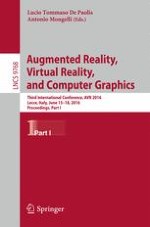The 2-volume set LNCS 9768 and 9769 constitutes the refereed proceedings of the Third International Conference on Augmented Reality, Virtual Reality and Computer Graphics, AVR 2016, held in Lecce, Italy, in June 2016.
The 40 full papers and 29 short papers presented werde carefully reviewed and selected from 131 submissions. The SALENTO AVR 2016 conference intended to bring together researchers, scientists, and practitioners to discuss key issues, approaches, ideas, open problems, innovative applications and trends on virtual and augmented reality, 3D visualization and computer graphics in the areas of medicine, cultural heritage, arts, education, entertainment, industrial andmilitary sectors.
